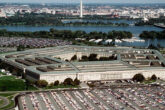August 26, 2021
Why America Can’t Build Allied Armies
The United States’ effort to strengthen the Afghan security forces has come to an ignominious end. The U.S. military spent 20 years and $83 billion building up a force that melted away in a matter of weeks, ceding the country to the Taliban over that period with barely a shot fired.
The swift collapse of the Afghan security forces is not an outlier. In fact, it is closer to the norm for local security forces built up with U.S. military assistance. The United States’ three largest efforts to build partner militaries—in Vietnam, Iraq, and now Afghanistan—have all failed spectacularly. There is good reason the images coming out of Kabul conjure up Saigon in 1975 and Mosul in 2014.
The United States’ partners are often uninterested in building militaries that can fight.
What the military calls “security force assistance,” “building partner capacity,” or “train-and-equip operations” remains a pillar of U.S. defense strategy. Setting Afghanistan and Iraq entirely aside, the United States spends billions of dollars every year and deploys thousands of personnel to train and assist foreign militaries from countries all over the world. Although the purpose of such assistance varies, its main goal is to increase the capacity of partner militaries to shoulder local security burdens so that the United States can shift its own resources to higher priorities.
The problem, however, is that the United States’ partners are often uninterested in building militaries that can fight. As Georgetown University Professor Caitlin Talmadge has shown, political and military leaders have to foster the promotion of competent officers, enforce a chain of command, encourage rigorous training, and put a lid on corruption to create an effective force. But in the weak or failed states where the United States focuses its security assistance, leaders often prioritize their personal and political survival over strengthening their nations’ militaries. These leaders often aim to use their military as a source of patronage or as a cudgel against their domestic political opponents. They may welcome the largess of U.S. military assistance, but they fear building a professional force that could threaten their own power. So they ignore the pleas of U.S. military advisers, implementing policies that keep their militaries weak.
Read the full article from Foreign Affairs.
More from CNAS
-
Lessons in Learning
Executive Summary Although claims of a revolution in military affairs may be overhyped, the potential for artificial intelligence (AI) and autonomy to change warfare is growin...
By Josh Wallin
-
The Pentagon Push to Change an “Antiquated” System
Carlton Haelig, a fellow at the Center for a New American Security, joined The Cipher Brief to discuss the systems in place in the Department of Defense and the challenges ass...
By Carlton Haelig
-
The Department of Defense’s Breakthrough Nuclear Moment Risks Slipping Away
Unless they act, the Department of Defense’s breakthrough nuclear moment may vanish before it really happens....
By Will Rogers
-
DEFAERO Strategy Series [Apr 09, 25] CNAS' Becca Wasser and Phil Sheers on Revitalizing the U.S. Defense Industrial Base
On this episode of the Defense & Aerospace Report Strategy Series, sponsored by General Atomics Aeronautical Systems, Becca Wasser and Phil Sheers of the Center for a New Amer...
By Becca Wasser & Philip Sheers




